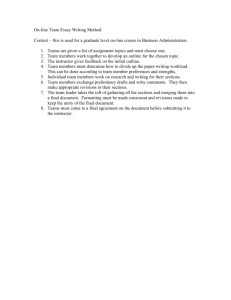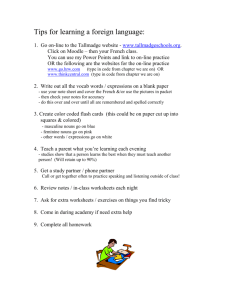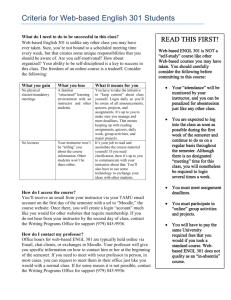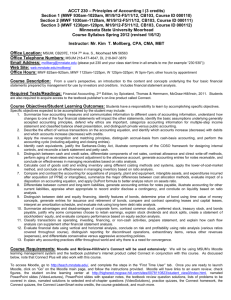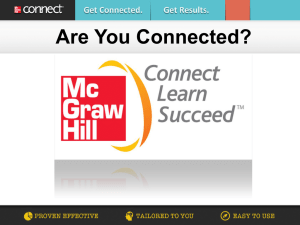ACCT 231 - Minnesota State University Moorhead
advertisement
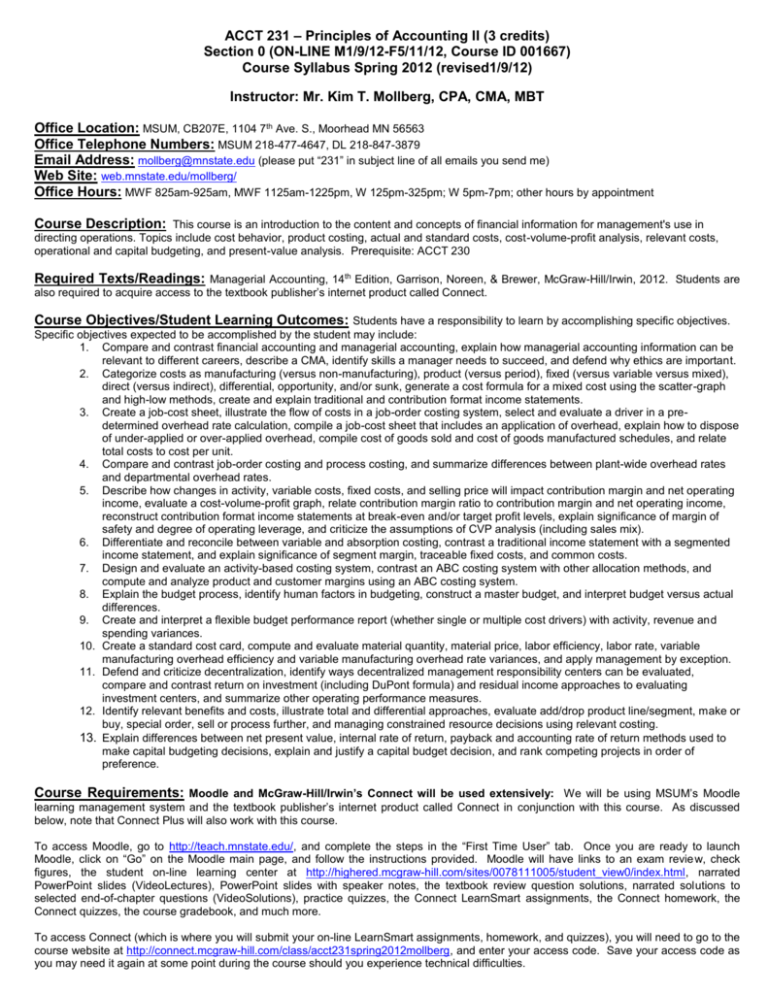
ACCT 231 – Principles of Accounting II (3 credits) Section 0 (ON-LINE M1/9/12-F5/11/12, Course ID 001667) Course Syllabus Spring 2012 (revised1/9/12) Instructor: Mr. Kim T. Mollberg, CPA, CMA, MBT Office Location: MSUM, CB207E, 1104 7th Ave. S., Moorhead MN 56563 Office Telephone Numbers: MSUM 218-477-4647, DL 218-847-3879 Email Address: mollberg@mnstate.edu (please put “231” in subject line of all emails you send me) Web Site: web.mnstate.edu/mollberg/ Office Hours: MWF 825am-925am, MWF 1125am-1225pm, W 125pm-325pm; W 5pm-7pm; other hours by appointment Course Description: This course is an introduction to the content and concepts of financial information for management's use in directing operations. Topics include cost behavior, product costing, actual and standard costs, cost-volume-profit analysis, relevant costs, operational and capital budgeting, and present-value analysis. Prerequisite: ACCT 230 Required Texts/Readings: Managerial Accounting, 14th Edition, Garrison, Noreen, & Brewer, McGraw-Hill/Irwin, 2012. Students are also required to acquire access to the textbook publisher’s internet product called Connect. Course Objectives/Student Learning Outcomes: Students have a responsibility to learn by accomplishing specific objectives. Specific objectives expected to be accomplished by the student may include: 1. Compare and contrast financial accounting and managerial accounting, explain how managerial accounting information can be relevant to different careers, describe a CMA, identify skills a manager needs to succeed, and defend why ethics are important. 2. Categorize costs as manufacturing (versus non-manufacturing), product (versus period), fixed (versus variable versus mixed), direct (versus indirect), differential, opportunity, and/or sunk, generate a cost formula for a mixed cost using the scatter-graph and high-low methods, create and explain traditional and contribution format income statements. 3. Create a job-cost sheet, illustrate the flow of costs in a job-order costing system, select and evaluate a driver in a predetermined overhead rate calculation, compile a job-cost sheet that includes an application of overhead, explain how to dispose of under-applied or over-applied overhead, compile cost of goods sold and cost of goods manufactured schedules, and relate total costs to cost per unit. 4. Compare and contrast job-order costing and process costing, and summarize differences between plant-wide overhead rates and departmental overhead rates. 5. Describe how changes in activity, variable costs, fixed costs, and selling price will impact contribution margin and net operating income, evaluate a cost-volume-profit graph, relate contribution margin ratio to contribution margin and net operating income, reconstruct contribution format income statements at break-even and/or target profit levels, explain significance of margin of safety and degree of operating leverage, and criticize the assumptions of CVP analysis (including sales mix). 6. Differentiate and reconcile between variable and absorption costing, contrast a traditional income statement with a segmented income statement, and explain significance of segment margin, traceable fixed costs, and common costs. 7. Design and evaluate an activity-based costing system, contrast an ABC costing system with other allocation methods, and compute and analyze product and customer margins using an ABC costing system. 8. Explain the budget process, identify human factors in budgeting, construct a master budget, and interpret budget versus actual differences. 9. Create and interpret a flexible budget performance report (whether single or multiple cost drivers) with activity, revenue and spending variances. 10. Create a standard cost card, compute and evaluate material quantity, material price, labor efficiency, labor rate, variable manufacturing overhead efficiency and variable manufacturing overhead rate variances, and apply management by exception. 11. Defend and criticize decentralization, identify ways decentralized management responsibility centers can be evaluated, compare and contrast return on investment (including DuPont formula) and residual income approaches to evaluating investment centers, and summarize other operating performance measures. 12. Identify relevant benefits and costs, illustrate total and differential approaches, evaluate add/drop product line/segment, make or buy, special order, sell or process further, and managing constrained resource decisions using relevant costing. 13. Explain differences between net present value, internal rate of return, payback and accounting rate of return methods used to make capital budgeting decisions, explain and justify a capital budget decision, and rank competing projects in order of preference. Course Requirements: Moodle and McGraw-Hill/Irwin’s Connect will be used extensively: We will be using MSUM’s Moodle learning management system and the textbook publisher’s internet product called Connect in conjunction with this course. As discussed below, note that Connect Plus will also work with this course. To access Moodle, go to http://teach.mnstate.edu/, and complete the steps in the “First Time User” tab. Once you are ready to launch Moodle, click on “Go” on the Moodle main page, and follow the instructions provided. Moodle will have links to an exam revie w, check figures, the student on-line learning center at http://highered.mcgraw-hill.com/sites/0078111005/student_view0/index.html, narrated PowerPoint slides (VideoLectures), PowerPoint slides with speaker notes, the textbook review question solutions, narrated solutions to selected end-of-chapter questions (VideoSolutions), practice quizzes, the Connect LearnSmart assignments, the Connect homework, the Connect quizzes, the course gradebook, and much more. To access Connect (which is where you will submit your on-line LearnSmart assignments, homework, and quizzes), you will need to go to the course website at http://connect.mcgraw-hill.com/class/acct231spring2012mollberg, and enter your access code. Save your access code as you may need it again at some point during the course should you experience technical difficulties. McGraw-Hill/Irwin actually has two on-line products which will work with this course, but only one of the two is required: Connect (which has no eBook) or Connect Plus (same as Connect but has an eBook). It is my understanding that the textbooks sold by the MSUM bookstore are bundled with Connect Plus (meaning students who buy their textbook from our bookstore will have both a loose-leaf textbook and an eBook, as well as access to Connect). If you already have a textbook, it is my understanding that Connect and Connect Plus are both available for purchase from our bookstore. Class and Chapter Schedule: Chapter On-line On-line LearnSmart Homework Assignment Due By Due By 1 Su1/15 W1/18 2 3 4 5 6 7 8 9 10 11 12 13 15 Su1/15 Th1/26 Th1/26 Th2/9 Th2/9 Th2/23 Th2/23 Th3/8 Th3/8 Th3/29 Th4/12 Th4/12 Th4/26 W1/18 M1/30 M1/30 W2/15 W2/15 M2/27 M2/27 W3/21 W3/21 M4/2 W4/18 W4/18 M4/30 On-line Quiz Due By On-line Proctored Exam Testing Window Other W1/18 Email Instructor your Proctor plans by Th1/12 F1/13 Add/Free Drop 4pm W1/18 M1/30 M1/30 W2/15 W2/15 M2/27 M2/27 W3/21 W3/21 M4/2 W4/18 W4/18 M4/30 M1/16 No Classes Tu1/31-W2/1 Ch1-4 TuW2/28-29 Ch5-8 TuW4/3-4 Ch9-11 TuW5/8-9 (earlier if you request) Ch12,13&15 M3/5 Summer Registration & Fall Advising MTuWThF3/12-16 No Classes M3/26 Fall Registration M4/2 “W” Date FM4/6,9 No Classes Tu4/17 Student Academic Conference Tu5/2 Study Day F5/11 Commencement & Grades Due Evaluation Standards/Course Grading Policy: Except as noted herein, you are responsible for all the material in the textbook whether or not it is specifically covered by the Instructor. Your grade will be based on the following points available during the semester: 1. Proctored Examinations (4) 400 Percentage of total cumulative points 2. On-line Quizzes (top 12 of 14) 120 A:94%-100%, A-:90%-93%, B+:87-89%, 3. On-line Homework (top 12 of 14) 120 B:84%-86%, B-:80%-83%, C+:77%-79%, 4. On-line LearnSmart Assignments (top 12 of 14) 120 C:74%-76%, C-:70%-73%, D+:67%-69%, 760 D:60%-66% Keep a personal record of scores for all examinations, quizzes, homework, and LearnSmart assignments. You can calculate your grade at any time by dividing your points earned to date by total possible points to date. Late examinations, quizzes, homework, and LearnSmart assignments will be scored zero. Periodically, the Instructor will update the Moodle gradebook (note that your scores in Connect will not automatically show up in Moodle). If any error has been made, it is the student’s responsibility to present written proof of the correct point total as soon as possible after the posting. That means you should SAVE ALL of your work until the end of the semester. If your grade falls below what is acceptable to you, take immediate action. DO NOT WAIT UNTIL THE LAST WEEK OF THE SEMESTER TO SEEK HELP. Consider the following, not necessarily in this order: (1) Are you working more hours and studying less? Can you correct that situation? (2) Form a study group. (3) Work extra problems and see the Instructor for solutions. (4) Seek assistance through the Academic Support Center and Disability Services (go to Flora Frick Room 154, or call 218-477-4318) and (5) Finally, the most important, see the Instructor on a regular basis. If you are repeating this course, note that only the higher grade will be used to compute your grade point average (GPA). Repeating a course more than once will result in the removal of only one previous grade from the student’s GPA computation. To assure that the GPA is correct, the student must submit a “Repeated Course” form to the Records Office. All course attempts will remain on the student’s permanent academic record. Examinations: Four (4) proctored examinations must be taken on-line in Connect during the testing windows indicated on the Class and Chapter Schedule. The examinations might include multiple choice, true/false, matching, fill-in-the-blank or essay questions. All examinations are DUE BY 11pm ON THE LAST DAY IN THE TESTING WINDOW for each examination as per Class and Chapter Schedule. The fourth exam will be considered your final examination and will emphasize Chapters 12, 13 & 15. Contact the Instructor if you need to take the final earlier than the testing window listed provided above. A Proctor is an unbiased, unrelated individual with no personal association or affiliation to you that makes sure you use no notes, textbooks, or other aids during the examinations. Only the Proctor will know the password required for you to access the examinations. As Instructor, I will plan on serving as proctor during my Wednesday night (5pm-7pm) office hours (W2/1 for first examination, W2/29 for second examination, W4/4 for third examination, and W5/9 for fourth examination). If you live on campus or in the Fargo-Moorhead metropolitan area, you should plan on me being your proctor. If you live outside the Fargo-Moorhead area or have a conflict with my office hours, you will need to find a proctor that is acceptable to me, understanding that your options are somewhat limited. MnSCU test proctoring services may be available at a campus located near your home. A list of MnSCU test proctoring centers in Minnesota can be found at http://minnesotaon-line.org/index.html. 2 Here is information for the proctoring center of Minnesota State Community and Technical College Moorhead: (730am-1000pm M-Th or 730am-500pm Fridays or 9am-1pm Saturdays). They ask that you please start your exam at least 2 hours before their end time. NOTE THEIR PROCTORING DAYS AND HOURS ARE DIFFERENT THAN THE TESTING WINDOW DAYS AND HOURS FOR THIS COURSE. Contact person: Perry Werner, 218-299-6531 or Carrie Curie and Kristen Larson, 218-299-6530, by appointment only - advance notification required. For students living anywhere in the US or abroad: · Most public libraries, universities and colleges will proctor exams. · National College Testing Services ( http://www.ncta-testing.org/cctc/find.php ) will proctor exams for a fee. · Sylvan Learning Center has a branch called ‘Prometric’ which does proctoring and assessment. The cost is $20 /hour with advanced appointment required (local address is 901 28th St S, Fargo, North Dakota 58103: local phone is 701-293-1234). Other test center locations can be found by visiting http://tutoring.sylvanlearning.com/ . Please send Instructor an email by Thursday, January 12th indicating your plans with respect to proctoring. On-line Quizzes: A total of fourteen (14) on-line quizzes with time limits will be given during the semester, of which you can throw out the two (2) lowest scores. You will be using Connect to take the on-line quizzes. All on-line quizzes are DUE BY 1155pm ON THE ON-LINE QUIZ DUE DATE for each Chapter as per the Class and Chapter Schedule. The on-line quizzes will generally consist of worksheet, problem-solving type questions (for example, some might require that you fill-in-the-blank, others might involve you choosing the best answer from the alternatives given). You are expected to do the on-line quizzes on your own without the help of others. Only one (1) quiz attempt allowed per Chapter. Note that many of the questions in Connect (whether in quizzes or homework) are algorithmic (meaning your current version of the question has the same words as another version, but the numbers have changed). You can review your answers from a previously submitted on-line quiz for which the due date has passed by clicking on the particular quiz in the Connect gradebook. Note that a particular quiz (or homework) in Connect might be worth (for example) 90 points according to Connect. However, when Instructor transfers that particular score over to Moodle, he will convert to a 10-point scale (since all quizzes and homework are worth 10 points each per the syllabus). On-line Homework: A total of fourteen (14) on-line homework sets with no time limits will be given during the semester, of which you can throw out the two (2) lowest scores. You will be using Connect to complete the on-line homework. All homework is DUE BY 1155pm ON THE ON-LINE HOMEWORK DUE DATE for each Chapter as per the Class and Chapter Schedule. You are expected to do the homework in a study group or on your own. Each student must submit his/her own homework to get credit. You can attempt the homework multiple times to improve your score (but remember the numbers may change if set up as an algorithmic problem). You can check your answers as you go, and also print out the homework in advance. You can review your answers from a previously submitted on-line homework by clicking on the particular homework in the Connect gradebook. This feature is available before the due date has passed, in the event you want to see what you did wrong, then retry for a better grade. LearnSmart Assignments: A total of fourteen (14) on-line LearnSmart assignments with no time limits will given during the semester, of which you can throw out the two (2) lowest scores. You will be using Connect to complete the on-line LearnSmart assignments. LearnSmart is an adaptive learning system designed to help students learn faster, study more efficiently, and retain more knowledge for greater success. You will earn either 10 points or zero points each Chapter (there is no partial credit). Each chapter LearnSmart assignment has been designed by the publisher to take up to one (1) hour to complete; actual time will vary by student. All LearnSmart assignments are DUE BY 1155pm ON THE ON-LINE LEARNSMART ASSIGNMENT DUE DATE for each Chapter as per the Class and Chapter Schedule. You are expected to do these on your own. Course Outline: (unless otherwise told by Instructor, assume we will skip all end-of-chapter and end-of-book appendices) 1. 2. 3. 4. 5. 6. 7. 8. Managerial accounting overview, including differences between financial accounting and managerial accounting, relevance of managerial accounting to various careers, CMA, skills managers need, and importance of ethics. Managerial accounting concepts, including introduction to general cost classifications (manufacturing versus non-manufacturing, product versus period, fixed versus variable versus mixed, direct versus indirect, differential, opportunity, and sunk costs), analysis of mixed costs (using scatter-graph and high-low methods), and preparation and analysis of traditional and contribution margin income statements. Introduction to job-order costing, including job-cost sheets and flow of costs in job-order costing systems, computation and analysis of predetermined overhead rates, applying overhead, disposition of under-applied or over-applied overhead, preparation of cost of goods sold and cost of goods manufactured schedules, and computation of unit costs. Overview of process costing, including comparison to job-order costing, flow of costs in process costing systems, computing departmental overhead rates and contrasting departmental rates with plant-wide rates. Cost-volume-profit basics, including calculation of contribution margin and contribution margin ratio, consideration of CVP relationships in equation and graphic forms, break-even and target profit analysis, and assumptions of CVP analysis (including sales mix). Overview of variable costing, including reconciliation between variable and absorption costing, and preparation and analysis of segmented income statements (including segment margin, traceable fixed costs, and common costs). Activity-based costing concepts, including defining activities, assigning overhead costs to activity cost pools, assigning costs in activity cost pools to cost objects, computation of product margins, comparison of product margins using ABC to product margins using other allocation methods, and computation of customer margins. Basics of budgeting, including advantages, consideration of human factors in budgeting, process of preparing the master budget, and budget versus actual analysis. 3 9. 10. 11. 12. 13. 14. Introduction to flexible budgets, including preparation and analysis of activity and revenue/spending variances, and preparation of flexible budgets with multiple cost drivers. Introduction to standard costs and variance analysis, including development of standards, and calculation and interpretation of material quantity variances, material price variances, labor efficiency variances, labor rate variances, and variable overhead efficiency variances, variable overhead rate variances, and introduction to management by exception. Advantages and disadvantages of decentralization, accounting for decentralized management responsibility centers, evaluation of investment center performance using return on investment (including DuPont formula) and residual income approaches, and overview of other operating performance measures. Identification of relevant benefits and costs, overview of total and differential approaches, application of relevant costing to add/drop product line/segment decisions, make or buy decisions, special order decisions, and sell or process further decisions, and managing constrained resources. Basics of capital budgeting decisions, including time value of money approaches (net present value and internal rate of return methods), and non-time value of money approaches (payback and accounting rate of return methods), and ranking of investment projects. Financial statement analysis, including vertical and horizontal analysis, ratio analysis (ratios used by common stockholders, shortterm creditors and long-term creditors). Other: School of Business Mission: We provide a quality undergraduate business learning experience designed to prepare students for successful and responsible careers. Faculty intellectual contributions are focused on learning and pedagogical research, discipline-based scholarship and contributions to practice. Through involvement in professional activities, the faculty also serves students, the University, and the community. School of Business Student Learning Goals: Students who graduate from Minnesota State University Moorhead with a major from the School of Business should be able to: -Exhibit basic knowledge of business principles and processes -Write in a clear and professional manner - Prepare and deliver an effective business presentation -Identify and analyze ethical issues in a professional context -Demonstrate basic understanding of business from a global perspective Time Requirements: Each student should expect to spend a minimum of 8-9 hours per week outside of class in preparation. This includes preparing for class, reading the text, completing the LearnSmart assignments, homework, and quizzes, and reviewing for examinations; anything less and you will be depriving yourself from obtaining your best grade. Emergency Procedures: If required to evacuate a classroom or building, students are to proceed to a clear and safe area away from the evacuated site. Take all personal belongings with you. If the emergency procedure occurs during an examination, the examination may be suspended and a new examination may be given at a later date. General: The course syllabus is subject to change. In particular, use the due dates in Moodle and/or Connect if different than the dates in this syllabus. In the event of a change, an announcement will be made in class, on Moodle, or through an email. It is the responsibility of the student to keep current and develop a clear understanding of all course policies. Classes missed or cancelled for any reason do not relieve the student of the responsibility for the material and/or assignments due that day or on any future class meeting dates. Attendance Policy: Students are expected to attend all class meetings unless they are ill or officially excused as the result of participation in a University function. In the case of individual absence due to jury duty or other legal obligations, the student must notify me prior to the absence. In the case of individual absence due to health or other emergency, the student must notify me as soon as feasible. Academic Honesty: The University expects all students to represent themselves in an honest fashion. In academic work, students are expected to present original ideas and give credit to the ideas of others. The value of a college degree depends on the integrity of the work completed by the student. When an Instructor has convincing evidence of cheating or plagiarism, the following actions may be taken: assign a failing grade for the course in which the student cheated or Instructors may choose to report the offense, the evidence, and their action to the Dean of their college or the Vice President for Academic Affairs. If the Instructor (or any other person) feels the seriousness of the offense warrants additional action, the incident may be reported to the Student Conduct Committee through the Student Support Services Office. The Student Conduct Committee will follow procedures set out in the Student Conduct Code. After its review of the case and a fair, unbiased hearing, the Student Conduct Committee may take disciplinary action if the student is found responsible (see Student Conduct Code for details). A student who has a course grade reduced by an Instructor because of cheating or plagiarism, and who disputes the Instructor’s finding, may appeal the grade, but only using the Grade Appeal Policy, which states that the student must prove the grade was arbitrary, prejudicial, or in error. Flood Policy: In the event of short-term campus closure, and unless otherwise notified, all instructors are required to continue engaging their enrolled students in instruction by using alternative methods of interaction. For this class, the methods of communication with students will be via Moodle, or email. I would encourage students to make sure they have access to both Moodle and email, and that they check them 4 periodically for updates. Future assignments (LearnSmart assignments, homework, and quizzes) will be assigned through Moodle, Connect, and/or email. If students are unable to come to campus, they can submit assignments using Moodle (if applicable), Connect (if applicable), email (as an attachment if applicable) or by US mail. Students will still need to complete LearnSmart assignments, homeworks, and quizzes by the applicable dates as specified in Moodle, Connect, and/or email. If you have not already done so, you are encouraged to sign up for the E2Campus emergency notification system (http://www.mnstate.edu/security/) which will be used to notify students about class cancellations and other emergency-related information. Special Accommodations: Students with disabilities who believe they may need an accommodation in this class are encouraged to contact Greg Toutges, Coordinator of Disability Services at 477-4318 (Voice), 1-800-627-3529 (MRS/TTY), toutges@mnstate.edu, Flora Frick 154C, as soon as possible to ensure that accommodations are implemented in a timely fashion. I hope you have an enjoyable learning experience. Good luck! 5


